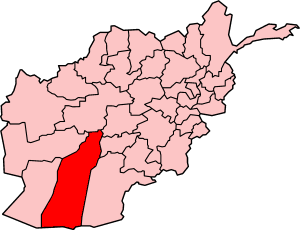Find Out All About Helmand

Helmand is one of the 34 provinces of Afghanistan. It is in the south-west of the country. Its capital is Lashkar Gah. The Helmand River flows through the mainly desert region, proving irrigation.
The population is 1,011,600 and the surface area is 23,058 square miles. The population is largely Pashtun.
Helmand produces 20% of the world's opium.
Contents
|
USAID Programmes
Helmand was the center of a U.S. development program in the 1960s - it was even nicknamed "little America". The program laid out tree-lined streets in Lashkargah, built a network of irrigation canals and constructed a large hydroelectric dam. The program was abandoned when the communists seized power in 1978.
More recently the American USAID programme has contributed to a counter-narcotics initiative called the Alternative Income Project (AIP) in the province. It pays communities to work to improve their environment and economic infrastructure as an alternative to Opium poppy farming. The project undertakes drainage and canal rehabilitation projects. In 2005 and 2006 there have been problems in getting promised finance to communities and this is a source of considerable tension between the farmers and the Coalition forces.
Current Military Situation
It was announced on January 27, 2006 in the British Parliament that a NATO International Security Assistance Force (ISAF) would be replacing the U.S troops in the province as part of Operation Enduring Freedom. The British 16th Air Assault Brigade would be the core of the force in Helmand Province. British bases are located in the towns of Sangin, Lashkar Gah and Gerishk.
As of Summer 2006, Helmand was one of the districts involved in Operation Mountain Thrust, a combined NATO-Afghani mission targeted at Taliban fighters in the south of the country. In July 2006, this offensive mission essentially stalled in Helmand as NATO, primarily British, and Afghani troops were forced to take increasingly defensive positions under heavy insurgent pressure. In response, British troop levels in the province were increased, and new encapments were established in Sangin and Gerishk. Fighting has been particularly heavy in the towns of Sangin, Naway, Nawsad and Garmser. There are reports that the Taliban see Helmand province as a key testing area for their ability to take and hold Afghan territory from NATO and Afghani troops.
News reports identifed the insurgents invovled in the fighting as a mix of Taliban fighters and warring tribal groups, primarily the Ishakzai and Alikozai, who are heavily involved in the province's lucrative opium trade.
Border with Pakistan
Helmand has a southern border with the Balochistan province of Pakistan. Many domestic and international observers have critcized Pakistan's efforts towards securing the border against Taliban insurgents, who are reported to use Balochistan as a training and staging area. Some reports cite the political alliance of Pakistan's military government with Balochistan's pro-Taliban Jamiat-e-Ulema Islam party as the reason for Pakistan's reluctance to commit to greater security measures.
Cities
- Sangin
Districts
- Baghran
- Dishu
- Gerishk
- Nawzad
- Musa Qala
- Sarwan Qala
- Lashkargah
- Zamindawor
- Kajaki
- Nad Ali
- Marja
- Khanashin
- Washir
- Sangin
Politicians
- Dad Mohammad Khan
- Sher Mohammed Akhundzada
- Engineer Mohammad Daoud
Helmand Provincial Government
